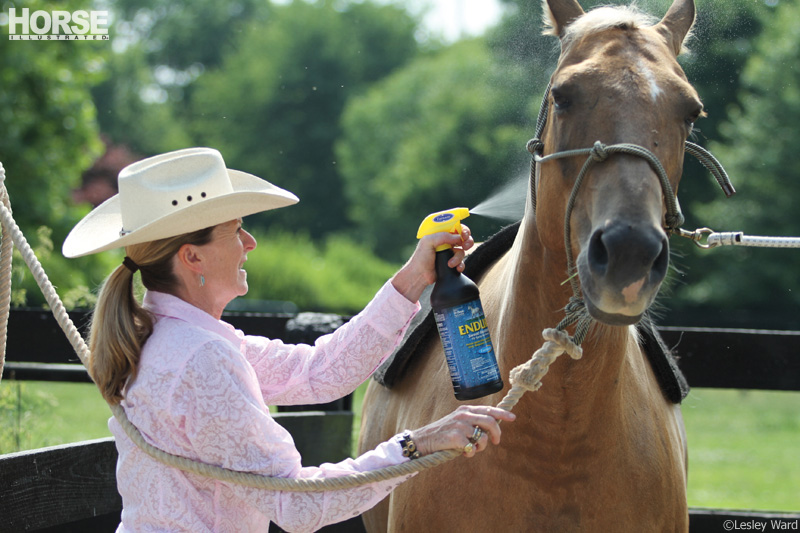
1. What is Lyme disease?
Lyme disease is a tick-borne illness caused by the bacteria Borrelia borgdorferi. It is named after the town of Old Lyme, Conn., where it was first identified.
2. Where does it occur?
Historically, it has been most prevalent in the Eastern United States, particularly in the Northeast and Mid-Atlantic states. Now it is also being seen throughout the Great Lakes region, particularly in Minnesota and Wisconsin. Reports of human infection have occurred in nearly all states, including those in the upper Midwest, as well as Florida, Texas and California.
Horses that are housed outdoors have an increased risk when living in an area where the disease is prevalent. Spring, summer and fall are particularly active periods for ticks.
3. What are the clinical signs of an infected horse?
Horses may demonstrate any number of clinical signs, although these may be vague and intermittent in the early stages. Signs of Lyme disease can often be confused with joint or muscle disease, or even symptoms related to equine protozoal myelitis (EPM).
- Fever that is persistent or recurring
- Lethargy
- Weight loss and reduced appetite
- Shifting limb lameness
- Inflamed and painful joints and/or stiff, achy muscles
- Muscle tremors
- Skin hypersensitivity
- Poor performance
- Behavioral changes
- Anterior uveitis (inflammation of the tissues that make up the pupil of the eye)
- Laminitis, particularly in insulin-resistant horses
4. Can horses transmit it to people?
Lyme disease is not transmissible from horse to person or vice versa; each is a dead-end host. Instead, it is contracted through the bite of an Ixodes tick, usually the common deer tick or black-legged tick.
A feeding tick typically acquires the disease from rodents, which harbor high levels of Lyme disease within their blood. The tick then bites a horse, person or other mammal to transmit the disease. Current research is looking into birds as another potential source.
In people, it causes fever, skin rashes, malaise, chills, headaches, muscle aches, joint pain and enlarged lymph nodes. In the weeks following an acute infection, this disease can cause serious heart problems, joint disease and neurologic signs.
5. How is it diagnosed?
Blood tests (ELISA, Western blot) are used to identify antibody levels in a horse suspected of having Lyme disease. Testing for antibodies can be fairly inconclusive in endemic areas, since 60 to 70 percent of horses may test positive, i.e. they’ve been exposed and have antibodies showing up in the blood but haven’t developed the active disease. It is also possible for the horse to test negative for the initial several weeks that the disease is in its incubation stage.
The newer Lyme multiplex PCR test (Cornell University) is very sensitive and can detect the DNA of whole or partial disease-causing organisms within tissue, blood, urine or cerebrospinal fluid. This test is able to detect antibodies as early as two to four weeks following infection, and can differentiate between an acute and chronic infection.
6. How is it treated?
The drug of choice in dealing with Lyme disease is one within the tetracycline family: oral doxycycline, intravenous tetracycline or a combination of these two. Treatment may be required for months to clear the infection. Beginning treatment as soon as possible is important for best results. The longer treatment is delayed, the less likely it is that the infection can be cleared, and the greater the risk of developing persistent arthritic or neurologic damage.

7. How can you prevent it?
There is currently no equine vaccine for Lyme disease. The canine vaccine is being used in horses, although it is considered an off-label use not approved for equine immunization.
Use of tick powders and insect repellents may help minimize tick infestation. Products containing permethrin and cypermethrin provide protection from ticks for several hours and prevent them from attaching to the horse. (Check the label—they should be labeled for tick protection.)
Clearing brush and other favorable tick habitats on your property is another important strategy. Remove dense cover from around the barn and areas where your horse hangs out. Grooming should be done daily to check for ticks and remove them. Look especially in soft-skinned areas like the groin, girth area, beneath the mane and tail, and along the legs.
A horse that has been infected and has recovered is able to contract Lyme disease again, so preventive precautions should be maintained.
8. What is the best way to remove ticks?
A tick should be removed as soon as possible, since the longer it remains on the horse, the greater the chance for disease transmission. In humans, the tick must be attached 12 to 24 hours for infection to occur, and the same is likely true in horses.
Take precautions when handling a tick; wear gloves or use plastic or a paper towel to avoid getting tick blood or body fluids on your skin. Grasp the tick close to the horse’s skin with your fingers or blunt-tipped forceps, and carefully pull it out without squeezing the main body of the tick. Be gentle so that you don’t leave parts embedded in the horse’s skin, which might happen if you pull too quickly and break off the tick’s head. Examine it after removal to see that its head and mouthparts are intact. Dispose of the tick by burning it, flushing it down the toilet, or placing it in a jar of alcohol.
Other home remedies for tick removal may cause more harm than good. Smearing on petroleum jelly, nail polish or alcohol may cause the tick to regurgitate its saliva into the wound, thereby increasing the likelihood of Lyme disease transmission. And trying to get a tick to back out by applying a hot match won’t be much appreciated by your horse as the flame nears his skin.
Further Reading
Summer Survival Tips for Riders
Question of the Week: Lyme Disease Outbreak
This article originally appeared in the July 2014 issue of Horse Illustrated. Click here to subscribe.






